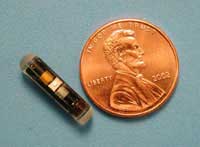
Sensors for Medicine and Science, Inc.
provides sensors based on fluorescence sensing. Currently they offer an
oxygen sensor and glucose sensor. Founded in 1997, the vendor developed
proprietary technologies for optical sensors.
Current state-of-the-art optical
sensors utilize fiber optic circuits in combination
with fluorescent indicator molecules.
Excitation light passes from the source through one
leg of a bifurcated fiber bundle to the sensing element
(a permeable polymeric matrix that contains the fluorescent
indicator molecules). A portion of the fluorescent light
emitted by the indicator is captured within the second
leg of the fiber bundle and delivered to a detector.
A key problem with such systems is poor optical efficiency
(i.e., how much of the energy provided by the initial
excitation light source is ultimately delivered to the
detector): the highest optical energy efficiency reported
in the scientific literature is 0.03%. As a result,
the signal-to-noise ratio is very low and sensitivity
is impaired. In order to compensate for this intrinsically
inefficient design and obtain higher signal strength,
very high quality components must be used. In addition
to the high cost of such components, high intensity
light sources destroy the indicator molecules, resulting
in a need for frequent recalibration and/or replacement
of the sensing element. The essence of the original SMSI
invention was to embed the excitation source in the
sensing element. Specifically, the invention places
a tiny, low cost LED in a matrix containing the fluorescent
indicator molecules (fluorophore).
sensors utilize fiber optic circuits in combination
with fluorescent indicator molecules.
Excitation light passes from the source through one
leg of a bifurcated fiber bundle to the sensing element
(a permeable polymeric matrix that contains the fluorescent
indicator molecules). A portion of the fluorescent light
emitted by the indicator is captured within the second
leg of the fiber bundle and delivered to a detector.
A key problem with such systems is poor optical efficiency
(i.e., how much of the energy provided by the initial
excitation light source is ultimately delivered to the
detector): the highest optical energy efficiency reported
in the scientific literature is 0.03%. As a result,
the signal-to-noise ratio is very low and sensitivity
is impaired. In order to compensate for this intrinsically
inefficient design and obtain higher signal strength,
very high quality components must be used. In addition
to the high cost of such components, high intensity
light sources destroy the indicator molecules, resulting
in a need for frequent recalibration and/or replacement
of the sensing element. The essence of the original SMSI
invention was to embed the excitation source in the
sensing element. Specifically, the invention places
a tiny, low cost LED in a matrix containing the fluorescent
indicator molecules (fluorophore).


Recent Comments